Dear Helen: I’ve noticed several different kinds of double-flowered primroses in garden centres and other plant outlets this spring. I’m wondering whether you can comment on them as garden plants.
P.F.
Dear P.F.: Three types I’ve seen being sold in recent years are the Double English primrose, the Ballerina Series, and Primlets.
Double English primroses are traditional cottage garden plants. The one called Quaker’s Bonnet has little pale mauve flowers and is the first to bloom in my garden. Sunshine Suzie in bright buttercup yellow is a favourite. Both have lived for many years in my garden, with only watering during dry summer weather and the occasional dividing.
They are perfect for placing along pathway edges and in up-front corners where the profusion of delicate blooms can be fully appreciated. The plants and flowers are small, not unlike double-flowered African violets.
In my experience, Double English primroses are among the easiest of garden plants. I hear from many gardeners about their enduring qualities even in far-less-than-ideal conditions.
Ballerina double primroses are larger plants with showy, ruffled double flowers. They are more recent additions to my garden. So far, my observation is that they bloom later than the Double English plants, making them useful for extending the primrose season.
Primlets, or Rosebud Primulas, are in between the two others in size and have a reputation for being tough and for giving an early and long flowering season. The blooms are very dainty doubles, featuring a swirl of petals. I’ll be observing to see whether the plants match their reputation in my garden conditions .
Dear Helen: I’ve been trying to find seeds for Night Phlox (Zaluzianskya capensis), but I can’t even find anyone who has heard of it. I understand it has a heavenly scent.
S.J.
Dear S.J.: Zaluzianskya capensis ‘Midnight Candy’ is listed in the Chiltern Seeds catalogue (chilternseeds.co.uk), which tags the plants as a “Best Seller” and goes on to say: “In the Night-Scented Stock order of excellence, this (fragrance) has been described as Daphne or Heliotrope-like.”
The perfume’s “indescribable loveliness can be detected at many paces from only a single plant. It is a charming species bearing over a long period in summer numerous short spikes of very striking white, Phlox or Lychnis-like flowers, purple-black on the outside.”
In case you’re wondering about the tongue-twisting botanical name, Night Phlox is named after Adam Zaluziansky von Zaluzian, “who, after a distinguished medical and botanical career, rose to become in 1593 Rector of the University of Prague.”
Chiltern (and Stokes Seeds) also lists Night Scented Stock (Matthiola bicornis), also a “Best Seller” and a plant that used to be a staple of prairie and cottage style home gardens. Chiltern maintains this is a plant “no garden, however large or small, should be without” for its “exquisite fragrance on the warm night air in summer. Very easy to grow — just sow patches at random in various parts of your garden, including outside your bedroom window.”
Dear Helen: I can’t find seeds for milkweed in any of my local garden centres. Can you give me a source for seeds or plants?
W.B.
Dear W.B.: Most seed catalogues list the milkweed that is especially valued for feeding Monarch butterflies, probably because of publicity about current losses of this necessary food source. Gardeners want to help.
West Coast Seeds (WCS) lists Asclepias tuberosa (butterfly milkweed), described as a drought-tolerant, deer-resistant perennial whose fragrant orange flowers are “intensely attractive” to butterflies and other beneficial insects. It is one of the plants the Monarch depends upon. Larvae (the caterpillars) of the Monarch depend on milkweed foliage as a food source.
Seeds will be available at retail outlets that carry a full line from WCS. Check out the Store Locator at westcoastseeds.com. Or order the seeds online.
If you want to be sure of flowers this year, WCS also sells Asclepias tuberosa roots. Some garden centres will also have the tuberous roots for sale. A few telephone calls may give you a source.
GARDEN EVENTS
Rose meeting. The Mid Island Rose Society will meet this afternoon from 3 to 5 p.m. in the meeting room of the new Nanaimo North Library, across from Green Thumb Nursery on Hammond Bay Rd.
Keeping chickens. The Koksilah Farmers Institute will offer an information session on keeping a small flock of chickens this evening at 7 in The Hub (formerly Cowichan Station School), Koksilah Rd, Cowichan Station.



